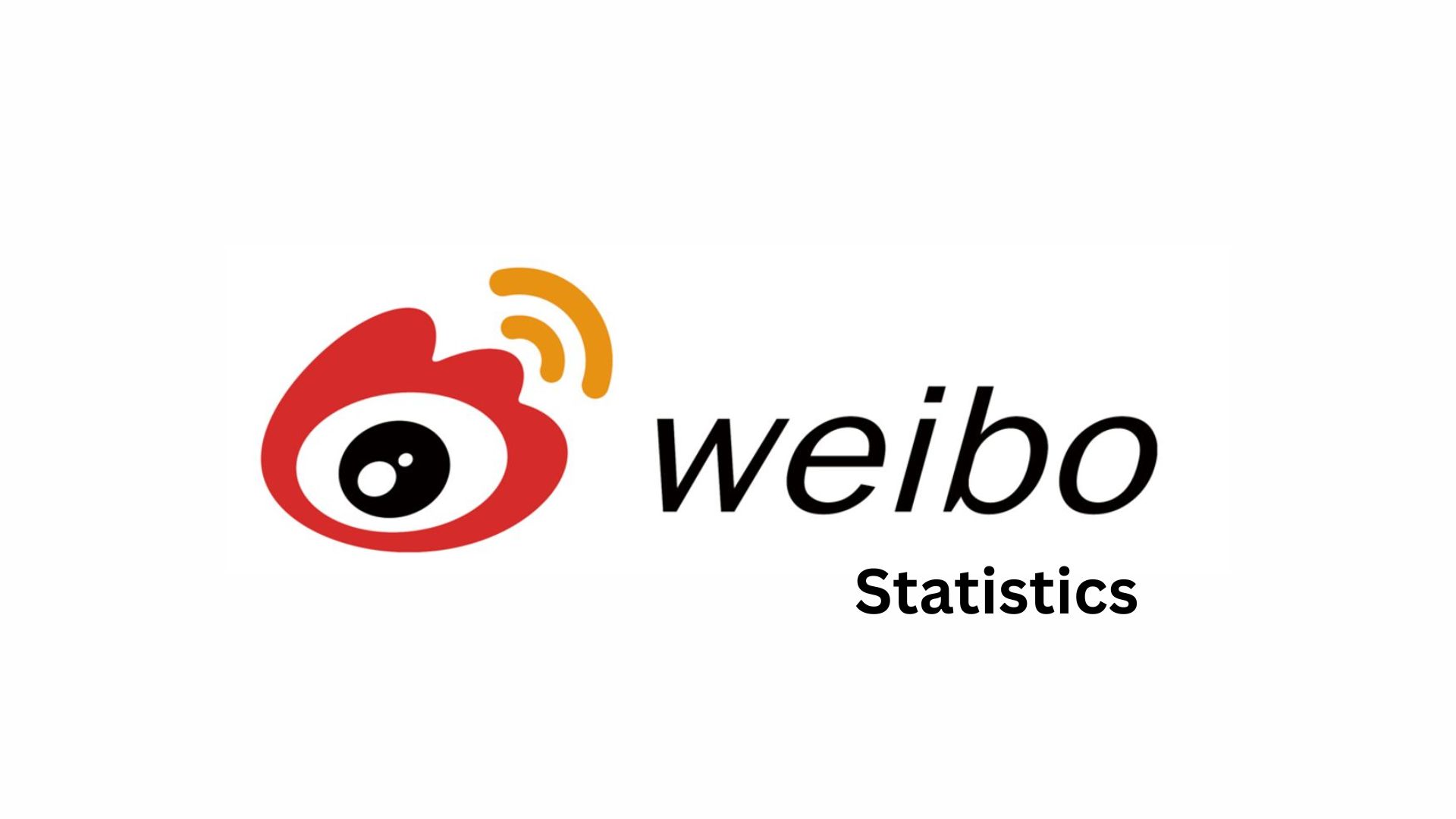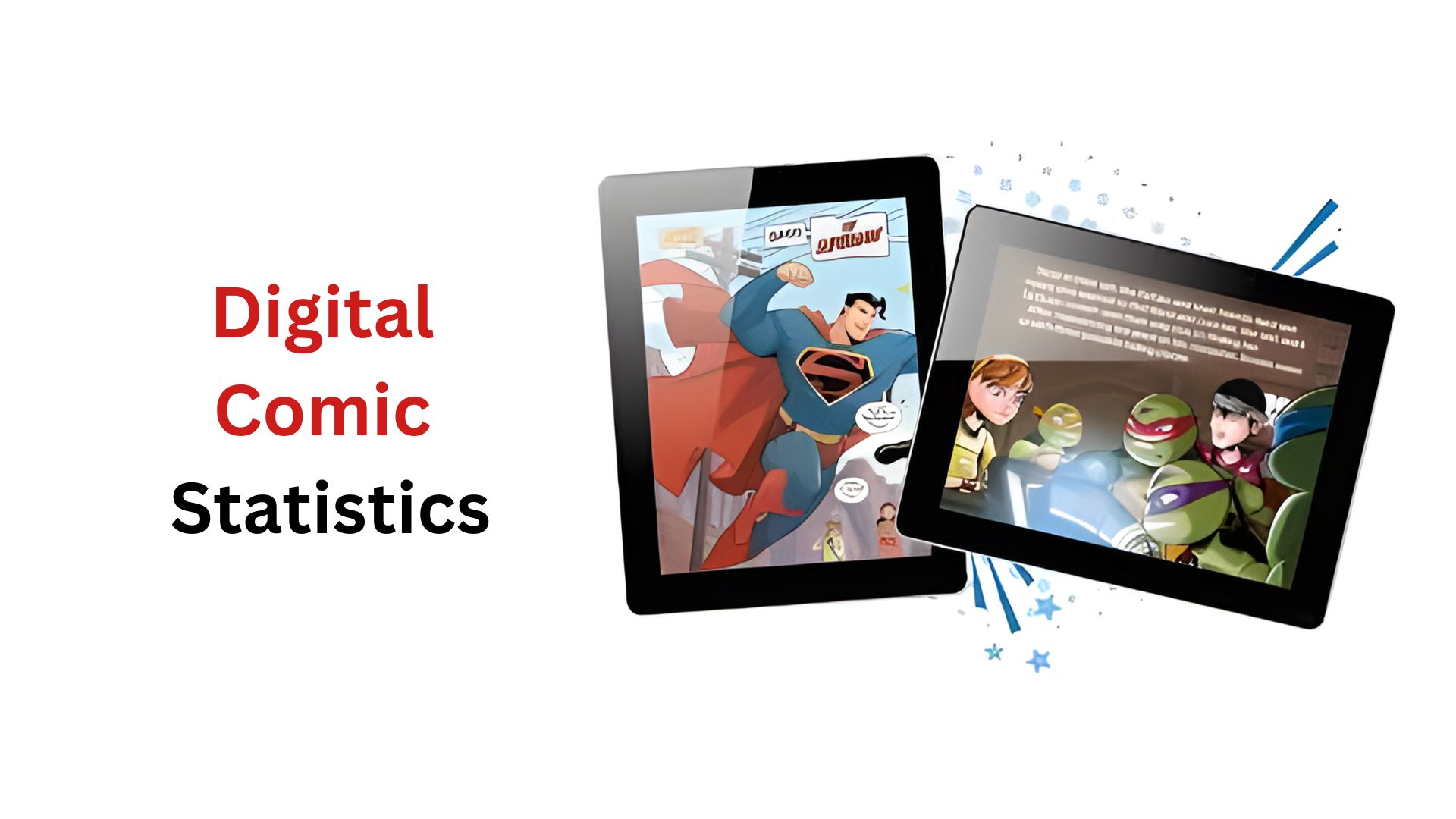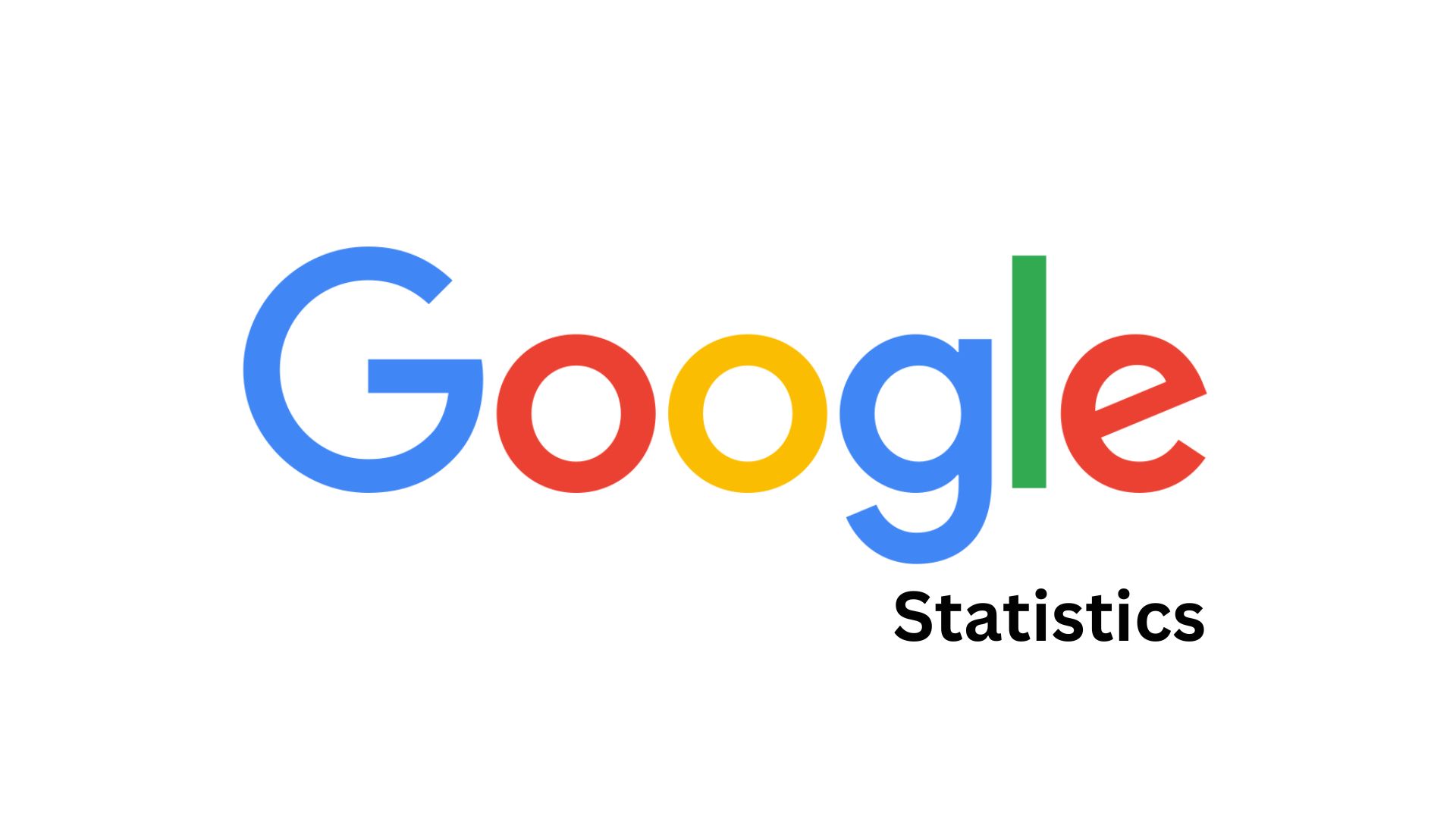Figma Statistics And Facts (2025)
Updated · Jul 02, 2025
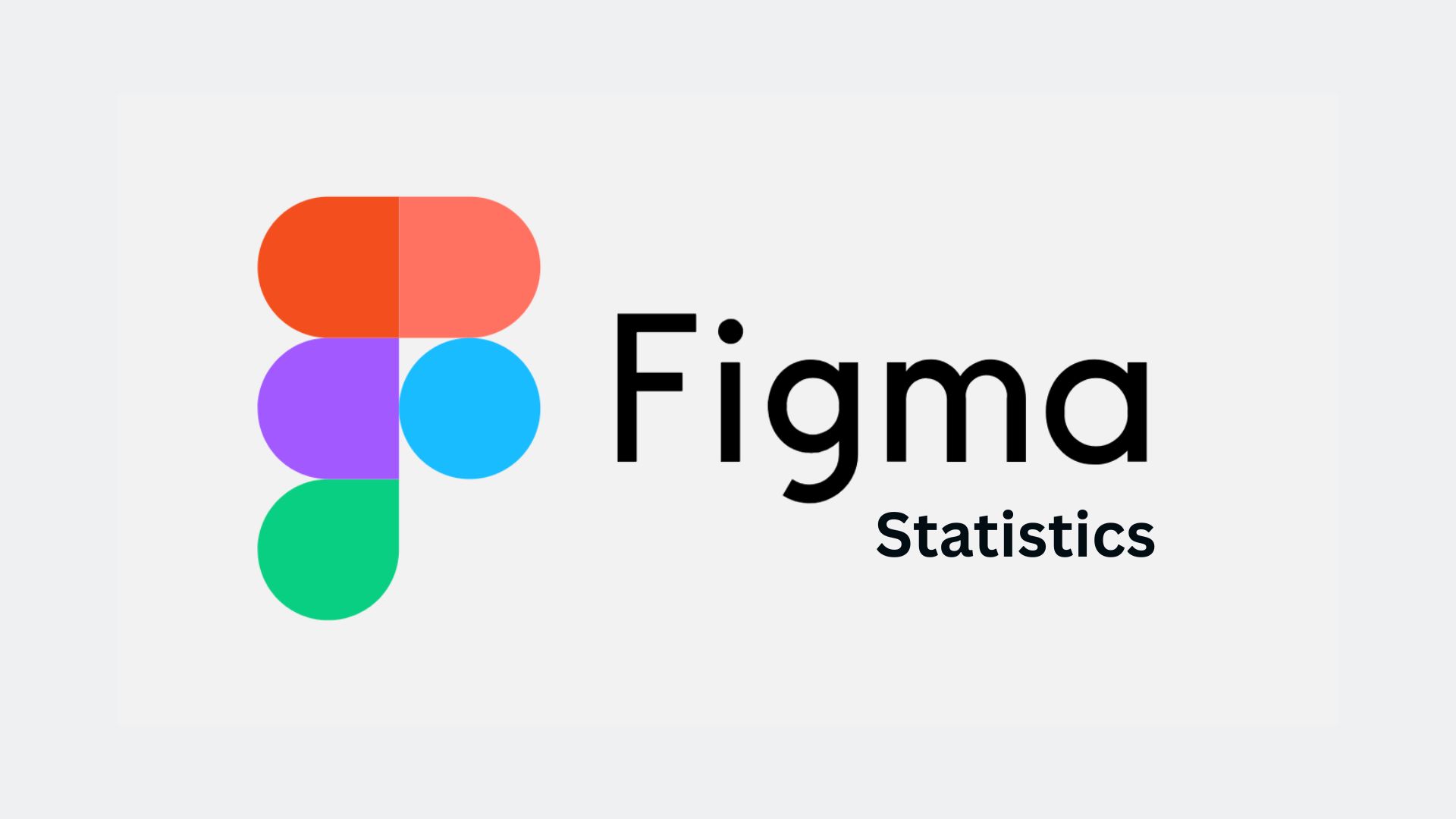
Table of Contents
Introduction
Figma Statistics: Figma, a cloud-based design and prototyping software, has fundamentally changed how teams cooperate on designing and producing digital products. Since its founding in 2012, Figma has come to be one of the most sought-after software among designers, developers, and companies around the world.
Figma statistics can be seen clearly in 2024 in terms of its not-so-pleasant statistics, showing a significant level of adoption and a great influence on the design arena.
Editor’s Choice
- According to Figma statistics, Figma’s user base growth at a rate of 159% indicates growing acceptance of remote collaboration tools.
- Tremendous revenue growth was achieved to US$400M in 2024, from US$190M in 2022 and just US$4M in 2018.
- The valuation stood at US$12.5B in 2024, with a Series F round of US$415.7M.
- Figma leads the UI/UX design with more popularity than its competitors, Sketch, Adobe XD, and InVision.
- Figma statistics state that investors have very high confidence, given the valuation during the many funding rounds, namely 2013 (US$10M) and 2024 (US$12.5B).
- Figma has also invested through Figma Ventures in 10+ portfolios, such as Scenery and Poly AI.
- The user base now exceeds 4 million and includes major clients such as Microsoft, X, Dropbox, Stripe, Slack, and GitHub.
- Figma statistics show that salaries are competitive, with an average annual rate of US$131,945, and executives can earn about US$720,000 annually.
- Culture is a good one and is well perceived by 94%, but working-life balance satisfaction stands at 56%.
- 89% of employees enjoy collaboration with their teammates, and 90% hold a favorable view of the CEO.
Key Facts
- Figma has been growing and reportedly reached about US$600 million in annual recurring revenue (ARR) for the year 2023.
- Figma statistics indicate that the firm consists of approximately 2,119 employees and caters to over 4 million users around the world.
- Going forward, it is expected that Figma will have its IPO in 2025, which may further solidify the company in the marketplace.
- It has received about US$333.6 million in funding from over 58 investors since its inception.
- Amongst competitors, Figma is more favored than design apps like Adobe XD, Sketch, and Framer but still enjoys less popularity than Canva.
- Figma has continued integrating AI into its platform, with the newly released FigJam update being packed with AI-driven features for better collaboration and productivity.
- Figma also invests in other companies, with around 10 such notable examples being Jam, Sprig, Impira, Replo, and Poly AI while developing its technology.
- As an employer, Figma is said to pay good salaries, with the average annual salary per employee estimated at US$131,945.
- Figma statistics reveal that the General Counsel is the highest-paid position at the company, with annual compensation of US$306,715.
- Employee satisfaction is relatively high, as evidenced by Glassdoor ratings, which have an average score of 4.3 for the company.
Fastest-Growing Apps To Support Telework Worldwide By Customers

(Reference: statista.com)
- Okta’s customers everywhere are adapting to the increase in collaboration tools for remote work and security tools for guarding their information.
- Among these tools, Notion has witnessed the highest growth, clocking in a raise of 240% in total customers.
- The web application developed by Notion Labs Inc., Notion, is a freemium culture-based productivity and note-taking tool.
- It contains various organisational functions such as task management, project tracking, to-do lists, and bookmarking, which make it a go-to app for individuals and teams trying to enhance their workflow process.
- Following closely behind, Figma is another tool that has witnessed significant growth in its customer base by 159%.
- This affirms that the demand for digital collaboration and design tools is increasing as businesses and professionals prioritise efficiency and security in remote work settings.
Figma Revenue
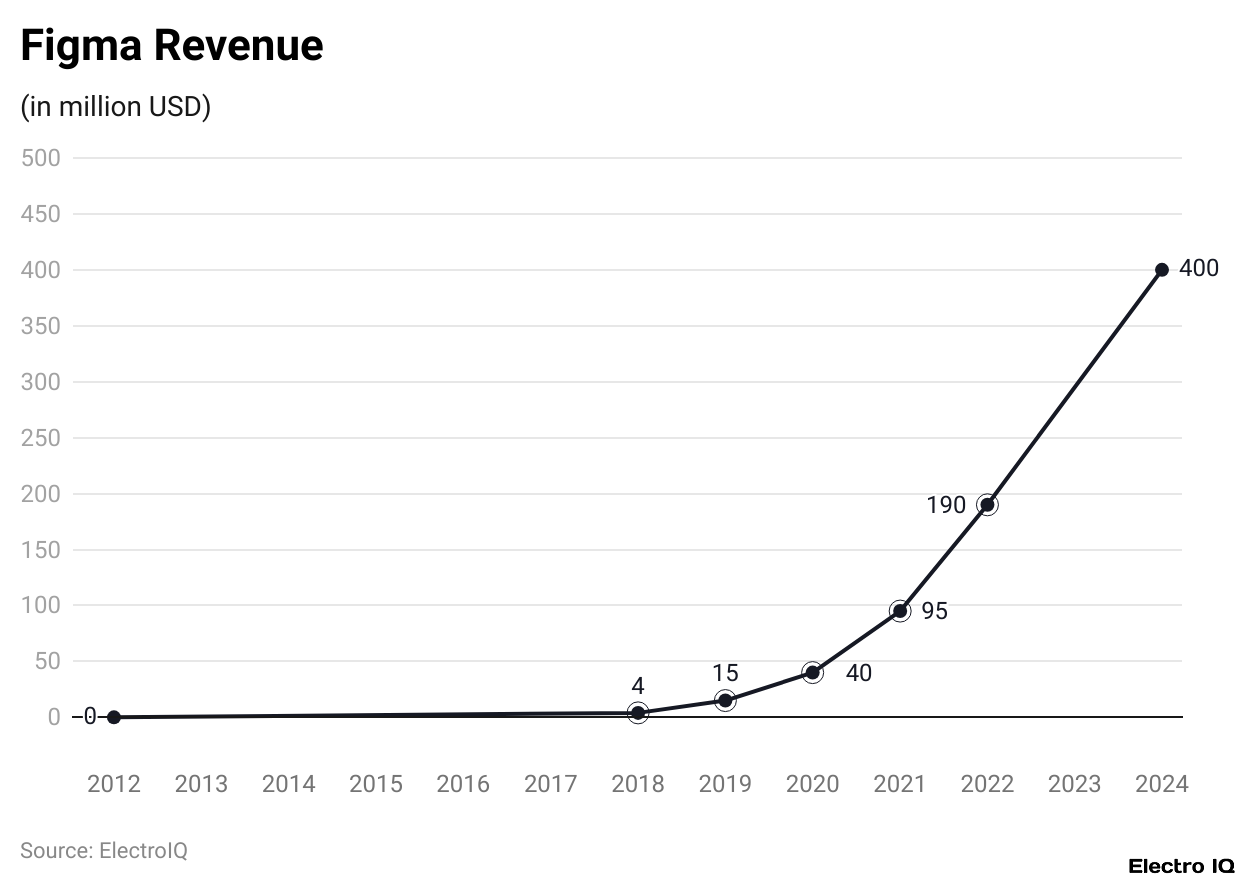
(Reference: getlatka.com)
- Figma has had an extraordinary revenue boom since the time of its birth in 2012; it continued to grow revenues as the user base expanded and adoption spread to several industries.
- The revenue stood at US$400 million in 2024, up from US$190 million in 2022. This upward trend just goes on giving credence to Figma’s increased desirability and uptake in design and collaboration.
- Figma statistics indicate that tracing previous revenue milestones, Figma’s revenue for 2022 was US$190 million, which was double from US$95 million in 2021. This saw a whopping stagger from US$40 million revenue for the company’s 2020 to US$15 million in 2019 and only US$4 million in 2018.
- Knowing such a history of growth for Figma gives credence to its increasing scale and user base every year. Growing strong within the competitive design software market maintains its constant streak of growth.
Figma Valuation
| Year | Funding Round | Details |
| 2024 | Series F |
Figma raised $415.7M at a $12.5B valuation in May, 2024
|
| 2021 | Series E |
Figma raised $200M at a $9B valuation in June, 2021
|
| 2020 | Series D |
Figma raised $50M at a $1B valuation in April, 2020
|
| 2019 | Series C |
Figma raised $40M at a $400M valuation in February, 2019
|
| 2018 | Series B |
Figma raised $25M at a $90M valuation in February, 2018
|
| 2015 | Series A |
Figma raised $14M at a $34M valuation in December, 2015
|
| 2013 | Seed Round |
Figma raised $3.9M at a $10M valuation in June, 2013
|
(Source: getlatka.com)
- Figma has been through many funding rounds since the time of its inception and has gradually hiked up its valuation and raised a lot of funding to pursue growth with its company.
- Figma statistics indicate that in 2024, the company raised US$415.7 million as part of its Series F funding round, which brings the company valuation to US$12.5 billion.
- The latest known round shows the kind of faith the investors are putting in to continue propelling Figma’s growth and market dominance.
- Before this, in June 2021, Figma raised US$200 million in a Series E round while achieving a valuation of US$9 billion.
- Earlier in April 2020, the company raised US$50 million against a valuation of US$1 billion in the Series D funding round, marking its entry into the unicorn club.
- The year preceding also saw Figma receive US$40 million in a Series C round in February, after which it reported a valuation of US$400 million.
- Going a bit backward, Figma raised US$25 million in February 2018 through a Series B round, without skipping a valuation-hopping amount of an estimated US$90 million.
- The round earlier happened in December 2015, where Series A got US$14 million and pegged a valuation at US$34 million.
- The first major investment occurred in June 2013 in the seed round, where it raised US$3.9 million at a valuation of US$10 million.
- These fund collections substantiate the fact that Figma is growing day by day, consolidating increasing investor faith and growing influence in the design software industry over the years.
Figma Popularity
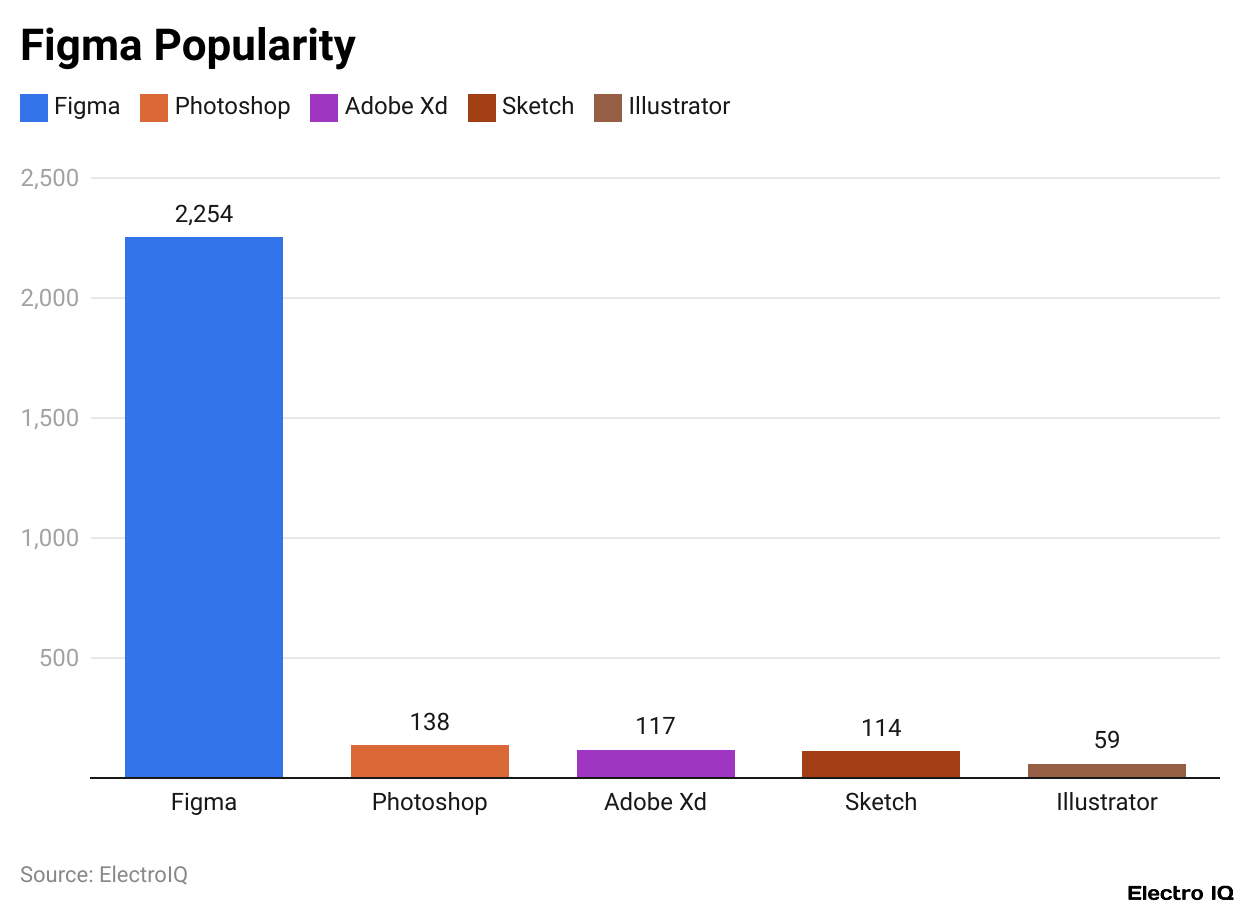
(Reference: auditshq.com)
- Figma has established itself as the best tool for UI design, and every year, it is voted number one among designers from all over the world.
- It has maintained the top performance over the last four years of 2020, 2021, 2022, and 2023, and the organization looks forward to even greater popularity in 2024 and beyond.
- The rise of Figma has been quite remarkable. In 2017, UX Tools conducted a survey that showed that 7% of the respondents were using Figma. In comparison, the dominant player in the market, Sketch, commanded 45% of the users.
- However, in 2023, the share of designers using Figma has already ramped up to a staggering 90%, while that of Sketch has dwindled to a mere 4.5%.
- This indicates the speed at which Figma is getting upwardly adopted and increasingly preferred by design professionals.
- Figma’s dominance over the industry has also sent tremors through competing design tools.
- The huge popularity it gained eventually led to the discontinuation of Adobe XD and InVision, as both couldn’t perform to the level best against Figma in all aspects of features, collaboration, and growing user bases. This is an example of Figma’s impact in the landscape of the UI/UX design field.
Figma Investments
- Figma is not just a leader in design software but also actively invests in budding companies all over the world through Figma Ventures.
- Figma statistics show that as of March 2024, they have invested in several companies, including Jam, AtoB, Sprig, Replo, Impira, Poly AI, Diagram, Scenery, ServiceBell, and Common Paper.
- Figma wants to foster innovation in technology and design-related sectors by supporting promising companies with disruptive ideas.
- One of their key investments through Figma Ventures was made in Scenery, a video-editing tool based in Burlingame, California.
- On June 17, 2022, Scenery completed US$14.6 million in Series A fundraising from investors Greylock, Craft, Figma Ventures, and Night Ventures.
- The company was founded in 2019 by Mike Folgner, Ryan Cunningham, Chris Martin, and Ashot Petrosian.
- Figma has invested in Poly AI, which uses AI to generate art assets. Supported by Y Combinator, it raised US$3.9 million on December 28, 2022.
- Other investors included Felicis, Bloomberg Beta, NextView Ventures, Y Combinator, Figma Ventures, and the AI Grant.
- By making these strategic investments, Figma not only extends its reach within the design and tech ecosystem but also nurtures the development of companies that hold complementary values concerning advancing creativity and collaboration.
Figma Users
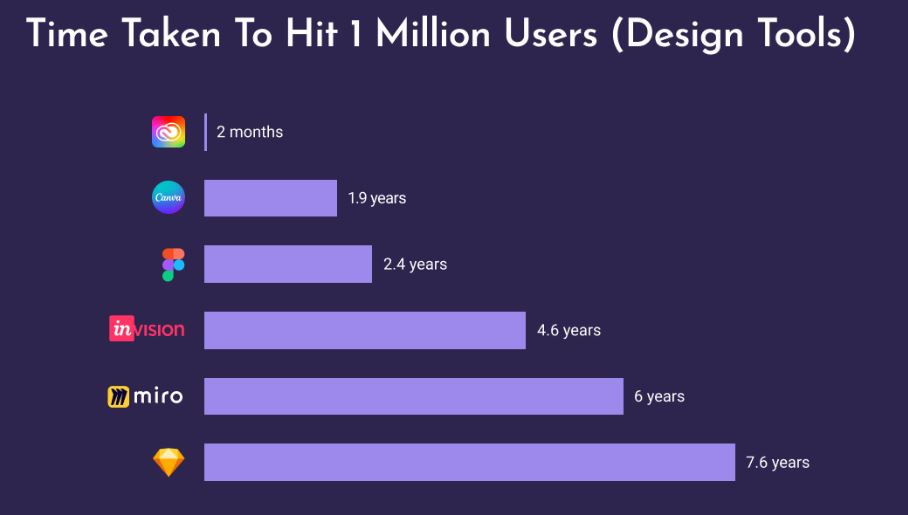
(Source: auditshq.com)
- As of March 2024, Figma has garnered about 4 million users, including many major tech companies as its customers.
- Microsoft, X (Twitter), Dropbox, Rakuten, Stripe, Slack, GitHub, and Mailchimp are some examples of organisations using Figma for design and collaboration, showcasing its robust stature in the industry.
- The breakout growth that Figma is experiencing is unparalleled with other design tools like Canva, Sketch, Adobe Creative Cloud, InVision, and Miro.
- A growth comparison graph shows how fast Figma reached 1 million users as compared with these competitors.
- The Figma statistics prove that Figma is steadily gaining traction from individuals and larger enterprises alike, further cementing its status as one of the leading design and prototyping tools in the market.
Figma Employee Salary
- As of March 2024, it has been understood that being employed by Figma brings a competitive salary, with an average of US$131,945 per annum or around US$63 per hour.
- Figma statistics show that the estimated median salary goes a little above that at US$154,155 or US$74 per hour.
- The highest-paid position at Figma happens to be that of General Counsel, bringing home US$306,715 annually, while on the lower end of the spectrum, an Administrative Assistant earns US$43,491 a year.
- Salary composition varies across Figma’s departments. Employees in the Product Department, on average, make about US$148,204 a year, whereas their colleagues in Engineering merely pull in a little bit more- US$ 148,849.
- The highest-paid department is Marketing, which earns an average of US$202,356, followed by Design with US$106,842.
- An Operations employee makes about US$117,447 on average, while the Admin Department bears one of the lowest salaries of US$45,327.
- Figma statistics state that the Business Development Department stands at US$134,021, Finance at US$95,520, and Customer Support at US$78,471.
- Professionals working in HR earn an average of US$112,735, IT employees earn US$128,963, and the Legal Department, which comprises the highest-paid position, averages US$306,715.
- Just behind this is the Sales Department, averaging US$290,290. In terms of compensation, Figma executives are paid even higher salaries, averaging US$276,191 yearly or US$132 hourly.
- The estimated median executive salary is US$271,659 or US$130 per hour.
- Figma statistics reveal that the maximum salary received by executives was a whopping US$720,000 annually, with the least-paid earning US$75,731. Generally, employee outlook is positive for the company.
- Based on Glassdoor reviews, the organisation has a rating of 4.3 out of 5. Around 90% approve of the CEO, and about 75% would recommend working at Figma to a friend.
- Therefore, this momentous level of approval reflects good employee satisfaction, faith in the leadership, and viability of a conducive working environment.
Figma’s Office Culture And Work Life
- Figma’s office culture and work-life balance reflect a positive and engaging setup that is empowering for employees.
- The work culture at Figma allows for flexible hours and a flexible work environment. The good aspect is that employees have a fixed basis for working, that is, 8-10 hours a day.
- Employees, on average, work 9.6 hours a day, which sets them in a structured yet flexible arena. Employees can also get about 20-30 paid vacation and sick days per year- adequate time for rest and some personal time.
- Figma employees also enjoy a constant improvement culture, wherein they receive constructive feedback regarding work at least once per month. There is also a great atmosphere at work, with 94% of employees rating it positively.
- When it comes to work-life balance, though, 56% seem to be satisfied, leaving room for improvement in this regard.
- Team collaboration is a big win in Figma’s culture, as 89% report that they look forward to working with their colleagues every day.
- These numbers point to a company that nurtures a supportive and engaging atmosphere, but it may also be prudent to see improvements in the area of work-life balance to provide a more holistic employee experience.
Conclusion
As per Figma statistics, the growth of Figma in 2024 emphasises the company’s vital involvement in the present-day scene for design and collaboration. With a huge user base, substantial revenue growth, and adequate adoption by other firms in the industry, Figma indeed makes a very important contribution to the future of digital design. Figma’s innovations, accessibility features, and user-centric design make it an innovative company in the design software competition.
FAQ.
Revenue growth for Figma has been very nice at an estimated US$400 million in 2024 versus around US$190 million in 2022 and just about US$4 million in 2018! The valuation has also skyrocketed, reaching US$12.5 billion by 2024, after raising US$415.7 million in Series F.
Figma is currently the leading UI/UX design tool and has surpassed its competition in other tools such as Sketch, Adobe XD, and InVision. By 2023, 90% of designers would be using Figma, while there was hardly a 4.5% market share of Sketch in comparison.
Leading tech companies such as Microsoft, X (Twitter), Dropbox, Stripe, Slack, GitHub, and Mailchimp are widely adopting Figma in the industry.
Employees have rated Figma highly, with 94% of employees rating its culture positively. Work-life balance satisfaction comes in at 56%, so room for improvement exists.
Figma Ventures has been involved in over ten startup investments, including Jam, Sprig, Poly AI, Scenery, and Replo, all in the pursuit of fostering innovation in the design and tech industries.

Maitrayee Dey has a background in Electrical Engineering and has worked in various technical roles before transitioning to writing. Specializing in technology and Artificial Intelligence, she has served as an Academic Research Analyst and Freelance Writer, particularly focusing on education and healthcare in Australia. Maitrayee's lifelong passions for writing and painting led her to pursue a full-time writing career. She is also the creator of a cooking YouTube channel, where she shares her culinary adventures. At Smartphone Thoughts, Maitrayee brings her expertise in technology to provide in-depth smartphone reviews and app-related statistics, making complex topics easy to understand for all readers.







